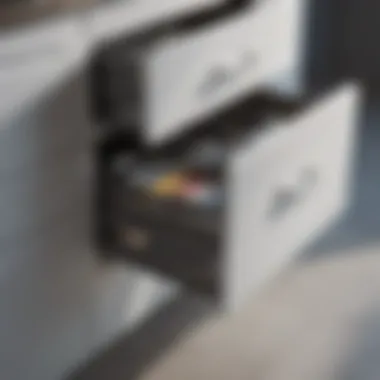Understanding Plastic Drawer Runners: Types and Benefits


Intro
Overview of Topic
Plastic drawer runners are integral components in modern furniture. Their purpose is to facilitate the smooth operation of drawers, making them easy to open and close. This functionality is essential, whether in kitchen cabinets or office desks. The importance of plastic drawer runners lies in their ability to universally adapt to various designs and configurations, enhancing the user experience in everyday activities.
By understanding plastic drawer runners, homeowners can appreciate how these simple yet vital parts impact furniture efficiency and longevity. In an era where home improvement and organization are paramount, selecting the right drawer runners becomes a pivotal decision.
Common Challenges and Solutions
Homeowners often face issues with drawer operation. Some common challenges include:
- Sticking drawers: Drawer runners can wear over time or can be improperly installed, leading to drawers that stick.
- Noise during use: This can arise from dust accumulation or the material degrading.
- Limited weight capacity: Some types may not support heavier loads, resulting in potential breakdowns.
To address these challenges:
- Keep the runners clean and lubricate them regularly.
- When installing, ensure proper alignment to minimize wear.
- Choose heavy-duty runners if you often store larger items.
Product Recommendations
When selecting plastic drawer runners, some brands stand out in the market. The following products are known for their quality and performance:
- Blum: Renowned for motion technologies that decrease noise and increase ease of use. Their selections are reliable for numerous applications.
- Hettich: Offers a variety of runners that are adaptable to different drawer sizes, supporting heavier loads without compromise.
- Accuride: Focuses on durability and smooth operation, ideal for commercial and residential needs.
Each of these brands brings specific advantages that can meet distinct requirements, providing users with durable long-lasting options.
Step-by-Step Guides
Implementing plastic drawer runners successfully involves a few practical steps:
- Planning: Measure the existing drawer sizes and consider the chosen runner type while planning your purchase.
- Purchase: Buy the runners, ideally ensuring compatibility with your drawer types.
- Remove old runners: Carefully unscrew and take out broken or old runners.
- Install new runners:
- Test: After installation, test the drawer closings to confirm smooth operation.
- Align the new runners to the marked anchors in the drawer.
- Secure them with screws, ensuring they are tightly fastened.
By following these steps, homeowners can ensure the investment in plastic drawer runners serves its purpose effectively, leading to better use of space and improved functionality.
Preamble to Plastic Drawer Runners
Importance of Plastic Drawer Runners
Plastic drawer runners play a central role in the functionality and usability of storage systems within modern cabinetry. Recognizing their importance is critical for homemakers and property owners looking to optimize storage solutions. These components aid in the seamless operation of drawer mechanisms, reducing strain on the materials and allowing for optimal use of space.
By using plastic rather than metal or wood, manufacturers enhance durability while maintaining a lightweight structure. This results in easy installation and maintenance. High-quality plastic runners resist wear, are immune to rust, and often come in various sizes to accommodate diverse drawer systems.
Thus, understanding plastic drawer runners is not merely about knowing their function; it's also about recognizing how they can significantly impact efficiency in everyday use.
Definition and Purpose
Plastic drawer runners are essential components engineered to facilitate the sliding mechanism of drawers. Their primary purpose is to create a no-friction path for smooth opening and closing of drawers. They prevent wear and tear associated with improper drawer movement. The reinforced structures of these runners bear load, ensuring stability as the drawer is extended. Without these runners, the reliability and functionality of drawers would be compromised, leading to frustration in their use.
They often come in a variety of types and sizes, catering to different drawer installations and functions. While most homeowners may overlook them, understanding their significance can lead to better choices in cabinet design and efficiency.
Historical Context
The evolution of drawer runners is significant in furniture design history. The initial designs incorporated stainless steel or wooden elements. Although effective at the time, they had limitations, particularly regarding compatibility and maintenance. For instance, traditional materials often led to rusting or warping, substantially reducing the drawers’ lifespan.
With progress in material science, plastic emerged as a viable alternative in offering a lightweight yet strong option. Introduced into cabinetry during the late 20th century, plastic drawer runners quickly gained acceptance among professionals and enthusiasts alike. The inherent properties of plastics afford flexibility in design and application.
Today, they are indispensable feature in contemporary furniture, balancing functionality with aesthetics. Their growth reflects shifting paradigms in product sustainability and user-centered design, proving their worth in every kitchen and storage area.
Types of Plastic Drawer Runners
Understanding the types of plastic drawer runners is vital for choosing the right one for your needs. Each type caters to different applications and has its own unique characteristics. Choosing appropriately ensures that you achieve optimum functionality and durability, depending on your intended usage. Below, we dive into three main types of plastic drawer runners: Standard Plastic Runners, Heavy-Duty Runners, and Adjustable Runners. Each serves distinct purposes and offers varied benefits, making thoughtful consideration necessary before making a decision.


Standard Plastic Runners
Standard plastic runners are the most common type used in various cabinets and drawers. These runners are designed for general usage, typically made from durable plastic materials that offer sufficient support for everyday items. They fit perfectly for light to moderate loads.
Advantages include:
- Ease of Installation: These runners are often simple to install, making them ideal for DIY enthusiasts. They come in various sizes that can fit standard drawer dimensions.
- Cost-Effective: Standard runners tend to be less expensive, making them accessible for most budgets.
- Variety: They come in multiple designs and colors, allowing for aesthetic customizations.
Limitations exist too. If you load overweight drawers consistently, this type might not hold up over time. Generally, these runners serve well for organizing textiles or other lighter items, keeping functionality in focus.
Heavy-Duty Runners
Heavy-duty runners provide superior performance for heavy-weight applications. Constructed from reinforced plastic and sometimes combined with metal elements, these runners are robust and reliable.
Key benefits are:
- Strength: They can support significant weight, making them suitable for kitchen cabinets or tool drawers, where heavier items are stored.
- Stability: These runners minimize wobbling or shaking when opening and closing, providing a smoother experience.
- Longer Lifespan: When installed properly, heavy-duty runners often outlast their standard counterparts, meaning fewer replacements over time.
As practicality aligns with sturdiness, people often see these runners as an investment. They serve significant advantages when load-bearing items are part of the cabinet design.
Adjustable Runners
Adjustable runners stand out due to their multifunctionality and versatility. They allow the configuration to change depending on the specific drawer's needs at any time.
Benefits of using adjustable runners include:
- Custom Fit: They can be tailored to fit different drawer sizes, making them adaptable.
- Ease of Modification: If drawer purposes change, the configurations can be readily altered without requiring a complete replacement of the runners.
- Innovative Storage Solutions: Adjustable runners are particularly useful in spaces where items may grow or decrease over time, such as craft areas or seasonal storage.
While initially more complex to install than standard options, unfortunate, tweeking them to one’s personal needs creates distinct advantages.
In summary, distinguishing between each type of plastic drawer runner helps one effectively select the right product. Weigh options according specific functionality and load requirements, as this choice significantly impacts the overall experience in organizing and utilizing storage space.
Materials Used in Plastic Drawer Runners
Understanding the materials used in plastic drawer runners is fundamental to appreciate their characteristics and functionality. Selection of materials significantly influences durability, performance, and sustainability. Choosing the correct type helps accomplish various design and application needs effectively.
Types of Plastics
Plastic drawer runners can be made from various types of plastics. Each type has distinct properties, affecting its reliability and functionality. Here are some prevalent options:
- Polypropylene: Known for its resilience and flexibility, polypropylene offers great resistance to chemicals. It is widely used in kitchen and bathroom drawers due to its water-resistant nature.
- Polyvinyl Chloride (PVC): This plastic is lightweight and affordable but can lack durability in demanding conditions. Hence, its application might be limited to lighter loads.
- Acrylic: Often used for clear display drawers, acrylic is characterized by its transparency and rigidity. It provides a modern look but may not withstand heavy weight as well.
- Polyamide (Nylon): Renowned for its strength, nylon can bear heavier loads. It also has good friction-resistance properties and can perform well without frequent maintenance.
Knowing these types helps in making informed choices:
- Load-bearing capacity
- Environmental considerations
- Visual aesthetics
Recyclable Options
In today's environment-conscious world, recyclable materials play an important role. When it comes to plastic drawer runners, there are options you should consider:
- Recycled Polypropylene: Some companies provide runners made from recycled polypropylene, contributing to sustainability by minimizing waste.
- Bioplastics: Emerging technologies have enabled the use of bioplastics in manufacturing drawer runners. These options are created from renewable resources, including starch, and offer biodegradability under the right conditions.
- Recyclable Markings: Ensure to choose drawer runners marked as recyclable. This signaling helps consumers make better decisions
Incorporating recyclable materials in plastic drawer runners not only enhances sustainability but also fosters a circular economy, where products are reused and minimized in landfills.
By understanding the materials, types, and the possibilities of recyclability, homeowners can create functional and environmentally positive spaces tailored to modern living needs.
Advantages of Using Plastic Drawer Runners
Plastic drawer runners are essential components in various types of cabinetry. Understanding their advantages helps homeowners appreciate their role in modern furniture design. Unlike traditional materials, plastic provides several unique benefits. One can think of durability, the simplicity of upkeep, and overall cost savings as the cornerstones of why plastic drawer runners are in demand.
Durability and Longevity
One standout characteristic of plastic drawer runners is their resilience. Plastic materials, such as polypropylene and polyamide, inherently resist wear and tear over time. They perform exceptionally well under various conditions. For example, they can handle constant use without degrading or fraying easily. Consider the daily movements in household drawers; these runners can support the weight of contents while allowing for smooth sliding mechanisms.
Many homeowners report their plastic runners lasting several years without showing significant signs of damage. This durability becomes vital, especially in busy environments with constant opening and closing of drawers. When planning for the long-term, investing in quality plastic runners means less frequent replacements, which proves advantageous in a busy home.


Low Maintenance Requirements
Another attractive benefit is low maintenance needs. Unlike metal alternatives, plastic does not rust or corrode. This quality translates to less time and effort spent on upkeep. Wiping down the surfaces with a damp cloth will often suffice in terms of cleaning.
Because plastic drawer runners do not attract dust and grime like some materials can, they are appealing for those who prefer a hassle-free experience. Routine inspections for loose fittings are straightforward. If any issue does arise, replacements are typically simple and can often be accomplished without professional help. For homeowners, this ease simplifies everyday life and enhances satisfaction with their investment.
Cost-Effectiveness
Between the cost savings in terms of material and maintenance, using plastic drawer runners is financially savvy. Generally, the initial investment for these runners tends to be lower compared to alternatives like metal. This viability allows families to stretch their budget further, especially when outfitting multiple drawers or cabinets.
Furthermore, the longevity paired with low upkeep minimizes future spending on repairs or replacements. Many house owners find it worthwhile to pay less upfront while enjoying an extended lifespan and reduced maintenance expenses. When someone factors in these savings, plastic drawer runners emerge as a sensible choice that brings both practicality and financial wisdom.
Keeping these advantages in mind, it's clear why plastic drawer runners are a robust choice for modern drawers in homes and commercial setups alike.
Installation Process
The installation process of plastic drawer runners plays a significant role in achieving optimal functionality, usability, and longevity of furniture. A well-installed runner ensures smooth operation and reduces wear and tear over time. Proper installation helps to prevent common issues such as misalignment, unresponsiveness, or breakage under stress. Understanding this process is crucial as it not only affects the efficiency of the drawers but also their overall performance and lifespan. Before beginning the installation, it is necessary to gather the appropriate tools and understand the step-by-step guide to ensure that everything goes smoothly.
Tools Required for Installation
While installing plastic drawer runners may seem straightforward, having the right tools on hand can expedite the process and ensure precision. Here is a list of tools you should consider:
- Screwdriver: This is essential for securing the runners to the sides of the drawers and the cabinet.
- Drill: A power drill may be needed for creating holes, especially in solid surfaces.
- Measuring Tape: Accurate measurements are critical for alignment and spacing.
- Level: This tool helps ensure that everything is vertically aligned, which is vital for overall drawer operation.
- Pencils: To mark where holes will be drilled.
- Clamps: Useful for securing components in place while attaching runners.
- Safety Glasses: Recommended for protection when using power tools.
With these tools organized and accessible, you can begin the installation process.
Step-by-Step Installation Guide
The procedure for installing plastic drawer runners can be broken down into straightforward steps. Following these instructions will lead to a precise and successful installation:
- Preparation: Start by clearing the area and gathering all required tools. Ensure that the drawers and runners are clean and dry.
- Measuring & Marking: Use the measuring tape to determine where runners will attach. Use a pencil to mark the spots on both the drawer sides and cabinet.
- Drilling Holes: If attaching runners to solid wood surfaces, use the drill to create appropriate holes for screws. Ensure accuracy based on the previously marked positions.
- Positioning Runners: Line up the runners with the drilled holes. It is advisable to use a level to confirm vertical alignment before proceeding further.
- Securing Runners: Using a screwdriver, attach the runners securely to both the cabinet and the drawers. Ensure the screws are tightened sufficiently without over-tightening, which could lead to material damage.
- Testing Movement: Once installed, slide the drawers in and out several times. They should glide smoothly without any resistance. Adjust if necessary by slightly loosening screws and repositioning if you notice irregular movements.
Common Installation Mistakes
No installation process is immune from errors, and recognizing common mistakes can save time and frustration during this task. Here are some points to consider:
- Misalignment: Not measuring carefully can result in uneven installation, causing drawers that stick or don’t function smoothly.
- Over-tightening Screws: This can lead to cracking in plastic or loosening of runners over time, so it is vital to find a suitable balance when securing fasteners.
- Trying to Install on Incompatible Surfaces: Not all materials work well with plastic runners. Always consider material compatibility before proceeding.
Above all, taking time to pay attention to each step and common pitfalls can make a significant difference in the functionality and performance of your installed drawer runners. With the right tools and knowledge at hand, you can greatly enhance the ease of installation as well as its overall success.
Proper installation can lead to years of optimal performance, so approach the task with care and diligence.
Maintenance of Plastic Drawer Runners
Maintaining plastic drawer runners is vital for ensuring both the functionality and longevity of furniture. Attention to proper care can prevent common issues like sticking, wobbling, or complete failure of the runners. This section will guide how to keep plastic drawer runners in optimal condition, offering insights that housewives and homeowners will find beneficial.
Cleaning Guidelines
Cleanliness is essential in prolonging the life of plastic drawer runners. Regular cleaning prevents dirt and debris from accumulating, which can hinder movement and cause wear. It is recommended to follow these steps when cleaning:
- Use a Soft Cloth: Begin with a damp soft cloth to remove surface dirt. Avoid harsh chemicals, as they may degrade the plastic.
- Mild Soap Solution: For more substantial grime or sticky residues, a mild soap solution can be effective. Make sure to rinse off any soap with a clean, damp cloth afterwards.
- Check for Obstructions: While cleaning, inspect for any obstructions in the drawer runner. Small items or lint can block the smooth operation.
- Dry Thoroughly: After cleaning, ensure that runners are dried completely. Trapped moisture can lead to mold or bacteria growth, which is not only unsightly but also unhealthy.
- Apply Lubricant: Occasionally, a silicone-based lubricant can be applied to enhance smoothness. This is particularly helpful if the drawers start to resist movement.
By consistently following these guidelines, users can maintain the aesthetic and functional appearance of their drawer runners over time.
Identifying Signs of Wear and Tear
Awareness of potential signs of wear and tear in plastic drawer runners can lead to timely interventions. Recognizing early signs helps avoid more extensive damage and costly repairs. Common indicators include:
- Uneven Movement: If drawers do not glide open and closed smoothly, it could be a sign of deterioration in the runners. The initial sign may be a subtle drag.
- Cracks or Breaks: Regularly inspect runners for visible cracks or breaks in the plastic. Small fractures can grow larger under stress, affecting support and function.
- Noise During Operation: Unusual sounds while opening or closing drawers can indicate wear. Scraping or grinding noises can signal that some structural components have been compromised.
- Visible Dirt Build-Up: If excessive dirt is noted in tracks, the buildup could interfere with the mechanisms’ efficiency, leading to increased friction.
- Misalignment: If the drawers appear misaligned or sit unevenly, this may indicate supporting elements are compromised or that runners aren't installed correctly.
Recognizing these signs promptly allows homeowners to address the situation before it escalates, thus avoiding more severe problems in the future. Keeping track of these aspects in your routine can greatly enhance the performance and lifespan of plastic drawer runners.
Remember: Staying on top of maintenance can save time and money in the long run. Never delay care to take advantage of the benefits of plastic drawer runners.
Innovative Uses of Plastic Drawer Runners


Plastic drawer runners not only serve practical purposes but also find innovative applications in home and furniture design. Understanding these applications can be useful for homemakers and owners alike, leading to greater customization and organization opportunities. In this section, we will discuss how these runners can enhance furniture designs and their compatibility with modular systems, contributing to holistic living spaces.
Applications in Custom Furniture Design
The use of plastic drawer runners in custom furniture design allows architects and designers to create tailored solutions that meet specific needs. This functionality enhances usability and flow within living areas. Plastic drawer runners provide smoother movements and can support a variety of weights without compromising structural integrity. Designers often prioritize these runners when integrating into household items like cabinets and storage units where ease of access is crucial.
When envisaging a customized piece, consideration of materials and style without losing functionality is essential. Plastic drawer runners can be specifically chosen for color and finish, aligning with total design goals. Using recycled plastics gives an additional sustainability angle. These runners can also be outfitted with side or bottom rails, providing diverse configuration possibilities.
Benefits of Custom Designs
- Increased functionality: Custom furniture can maximize space utility.
- Design flexibility: Designers can choose materials and colors that complement existing decor.
- Enhanced Longevity: Robust plastic runners often resist wear and tear, ensuring long-term use.
“The perfect integration of plastic drawer runners in furniture design can truly transform the functionality of a space.
”
Integration with Modular Systems
Modular furniture systems increasingly rely on plastic drawer runners to maintain the adaptability and modularity of design. In modular setups, each component needs to serve multiple purposes without losing its integrity. Plastic drawer runners support this flexibility by easily facilitating movement and rearrangement of units. This empowers homeowners to adjust their spaces, whether it be altering layouts or enhancing storage options.
Additionally, the aesthetic appeal is maintained as these runners can be incorporated minimally. Their lightweight nature reduces the overall bulk of furniture pieces, allowing for streamlined, light-filled spaces. Thus, they become an integral part of modern, adaptable living spaces.
Key Considerations for Integration
- Compatibility: Ensure chosen runners match the modular design requirements.
- Weight Capacity: Check the weight limits suitable for your modular units.
- Aesthetics: Select runners that enhance the overall look of upgraded pieces.
Through these applications, plastic drawer runners have proved to be more than mere functional parts, but significant contributors to the design quality and practicality sought in modern furniture and living spaces.
Future Trends in Drawer Runners
Understanding the future trends in drawer runners is vital for homeowners and designers looking to enhance functionality and aesthetics in their cabinetry. As plastic technology continues to evolve, various trends will shape the drawer runner market. These trends focus not only on increasing efficiency but also on addressing environmental concerns and incorporating modern smart technologies. By knowing these trends, one can make informed decisions when designing or upgrading furniture.
Sustainability in Material Choices
Sustainability is becoming an essential consideration in many industries, including furniture design. Many manufacturers are now shifting towards using biodegradable plastics or recyclable materials for drawer runners. This change is driven by a growing awareness of the environmental impact of plastic production and waste.
- Advances in Bioplastics: These are plastics made from renewable sources, which help reduce reliance on fossil fuels. Companies are investing in research and development to create tough, durable, and environmentally friendly materials for drawer runners.
- Recyclability: Many current drawer runners can be recycled at the end of their life cycle, but future options promise even better alignment with recycling standards. The focus will remain on creating products that close the loop in the material stream.
“Sustainable material choices not only offer environmental benefits but also appeal to consumers who prioritize responsibility in their purchasing decisions.”
Integrating sustainable practices does provide challenges but it also sparks industry innovation, encouraging solutions that can meet consumer demand without compromising quality.
Smart Drawer Runner Technologies
With the rise of smart home technology, drawer runners are also moving into an era of automation. Smart drawer runner technologies are designed to enhance functionality through various advanced features. These can include:
- Soft-Close Mechanisms: Simple yet sophisticated, these runners cause drawers to automatically close softly, preventing slamming and enhancing user experience.
- Touch Opening Mechanism: Some modern designs allow drawers to open with just a light push or touch, eliminating the need for handles. This provides a clean, minimalist look.
- IoT Integration: As part of the IoT environment, intelligent drawer runners can track usage patterns. For example, they can monitor weight capacity and alert users when a drawer is overloaded, thereby increasing safety and avoid accidents.
Future trends indicate that drawer runners will become even more intuitive and integrated into the smart home ecosystem, enhancing overall convenience for households. This evolution reflects how technology is reshaping everyday items in the pursuit of efficiency and modern living.
Finale
The importance of the conclusion section in this article cannot be overstated. It serves as a synthesis of the rich information and insights discussed throughout the exploration of plastic drawer runners. The conclusion wraps together the main findings, providing clarity on the various aspects such as functionality, types, installation processes, and maintenance practices.
Summary of Key Insights
In summary, plastic drawer runners offer numerous benefits that cater to both practical needs and aesthetic preferences. The highlights include:
- Durability: Their robust construction ensures longevity, reducing the frequency of replacements.
- Cost-Effectiveness: These runners are not expensive, making them a practical choice for homeowners.
- Low Maintenance: Regular cleaning and simple inspections can prevent wear and tear, enhancing their life span.
- Sustainability: Many newer products are made with recyclable materials, aligning with modern demands for environmental responsibility.
- Versatility: They can find uses beyond cabinets, integrating well with custom furniture and modular designs.
Overall, the insights imparted enrich the reader's understanding and appreciation for plastic drawer runners, encouraging informed decisions in home improvement.
Final Thoughts on Plastic Drawer Runners
As we conclude, it becomes clear that plastic drawer runners are an essential component in both kitchen and furniture designs. While their utility in day-to-day operations is undeniable, their potential impact on overall room aesthetics is equally significant.
With advancements in technology and material design, the future looks promising. Homeowners should not only consider their current needs but also how these runners can adapt to future trends. From customizable options to smart technologies, the continuous development in this field invites further exploration.
In the realm of home enhancement, understanding the small yet crucial components like plastic drawer runners enables informed choices that positively impact function and design.
In summary, investing time to understand plastic drawer runners pays off, both in practical functionality and visual harmony in the home. It empowers homeowners to create informed, adaptable, and aesthetically pleasing environments.





